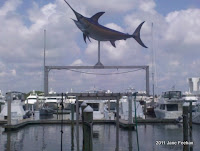 |
| Jolly Roger Hotel 1953, State Archives of Florida |
 |
| Pirate flag, Åland Maritime Museum * See below for more |
By Jane Feehan
A flag controversy at the opening of the Jolly Roger Hotel in 1953 sparked outrage—and a tradition.
The public was invited to opening night festivities at the 50-room, pirate-themed hotel, which included a display of treasure recovered from a Spanish galleon sunken off the Florida Keys. And what would a hotel named Jolly Roger be without a pirate flag, a jolly roger flag? Owner Bob Gill displayed the skull and crossbones pennant on a 75-foot mast along with the flag of the United States.
The July 29 festivities appeared on WFTL-TV. Soon after, calls, many from boaters, came into the station and to the Fort Lauderdale News about flag placement order. It appeared the pirate flag was placed in prominence over the U.S flag. Not only that, but some also said the flag should not be flown at night.
Gill was prepared, though the controversy didn’t end right away. The U.S flag can be flown at night if it was well illuminated, the hotelier said; lights were ablaze. Many said the two flags should not have been displayed together.
On the order of placement, hotel management cited the 1949 edition of Charles F. Chapman’s Piloting, Seamanship and Small Boat Handling. “Honor for national colors on land is as follows: on a straight mast, at the gaff.” The hotel mast had a gaff or yardarm. (At sea, a chaplain’s flag may be flown over the US flag only during services conducted by a Navy chaplain.)
Maybe it was the excitement of the festivities, the romance of piracy or the illumination of both flags, but overnight July 29-30, the skull and crossbones disappeared. Another pirate flag was on display a few days later; it was the first of many flag thefts and replacements. The pirate flag was grabbed again in 1955. Hotel management said the worst part of that incident was the car displaying it while cruising A-1-A in front of the Jolly Roger Hotel.
Fort Lauderdale News wrote that the pirate flag “seems to catch the eye of tourists who get the urge to bring it back home as a souvenir.”
It wasn’t just tourists who wanted that flag. Making off with it became a rite of passage for some kids. Many who grew up in 1950s and 60s Fort Lauderdale know of at least one jokester who stole the iconic flag. Known as the Sea Club Resort today, the hotel maintains a pirate theme, especially in the lobby. The hotel was given a historic designation by the city of Fort Lauderdale in 2009.
For some fun, let’s bring that flag back.
Pirate flag background
The jolly roger flag, so named by the British, is a skull and crossbones pennant first used in the early 1700s. Hoisted by pirates as an identifier in skirmishes or display of bravery or swagger, the traditional pirate flag was also raised by the British Royal Navy during World War II to indicate successful completion of a mission.
 |
| Sea Club today |
* Picture of flag above:
Pirate flag at the Åland Maritime Museum, one of two pirate flags that are considered authentic. The flag is about 200 years old and came to Åland from the North African Mediterranean coast, where piracy occurred right into the 19th century. It is made of cotton and was once dark brown. Now it is faded by the ravages of time, weather and wind. This photo has been color corrected by user Blockhaj to try to show the flag as it originally appeared.
Sources:
Fort Lauderdale News, July 29, 1953
Fort Lauderdale News, July 30, 1953
Fort Lauderdale News, Aug. 1, 1953
Fort Lauderdale News, Aug. 4, 1953
Fort Lauderdale News, Oct. 22, 1955
Fort Lauderdale News, Jan. 17, 1955
Fort Lauderdale News, Jan. 22, 1958
Fort Lauderdale Sun-Sentinel, Jan. 29, 2009
Wikipedia



























.jpg)